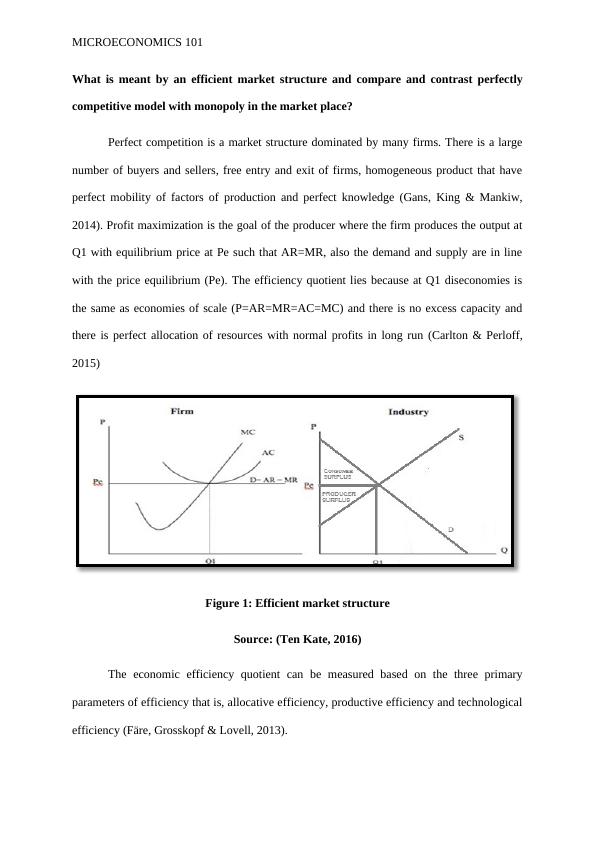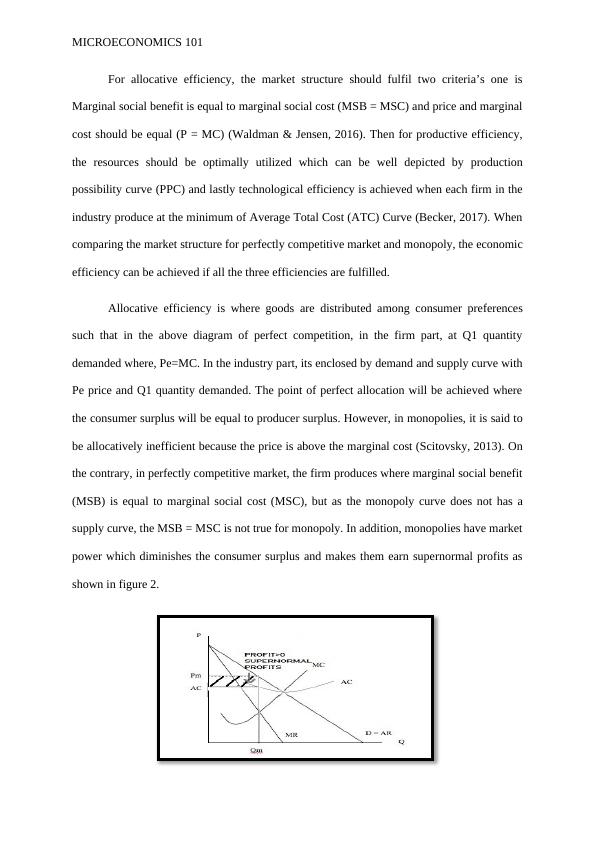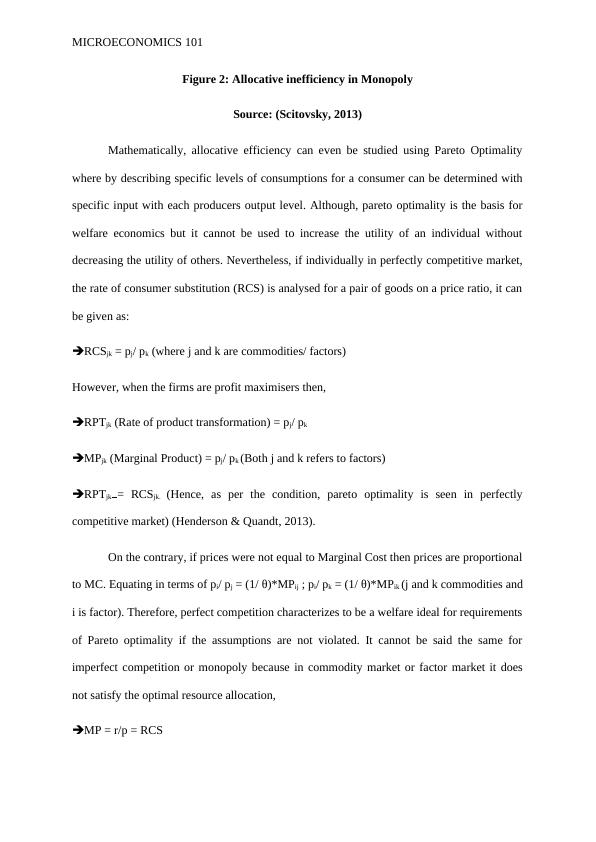Microeconomics 101: Economics Essay
Added on 2023-06-03
11 Pages2800 Words195 Views
Running head: MICROECONOMICS 101
Microeconomics 101: Economics Essay
Name of the Student:
Name of the University:
Authors Note:
Microeconomics 101: Economics Essay
Name of the Student:
Name of the University:
Authors Note:

MICROECONOMICS 101
What is meant by an efficient market structure and compare and contrast perfectly
competitive model with monopoly in the market place?
Perfect competition is a market structure dominated by many firms. There is a large
number of buyers and sellers, free entry and exit of firms, homogeneous product that have
perfect mobility of factors of production and perfect knowledge (Gans, King & Mankiw,
2014). Profit maximization is the goal of the producer where the firm produces the output at
Q1 with equilibrium price at Pe such that AR=MR, also the demand and supply are in line
with the price equilibrium (Pe). The efficiency quotient lies because at Q1 diseconomies is
the same as economies of scale (P=AR=MR=AC=MC) and there is no excess capacity and
there is perfect allocation of resources with normal profits in long run (Carlton & Perloff,
2015)
Figure 1: Efficient market structure
Source: (Ten Kate, 2016)
The economic efficiency quotient can be measured based on the three primary
parameters of efficiency that is, allocative efficiency, productive efficiency and technological
efficiency (Färe, Grosskopf & Lovell, 2013).
What is meant by an efficient market structure and compare and contrast perfectly
competitive model with monopoly in the market place?
Perfect competition is a market structure dominated by many firms. There is a large
number of buyers and sellers, free entry and exit of firms, homogeneous product that have
perfect mobility of factors of production and perfect knowledge (Gans, King & Mankiw,
2014). Profit maximization is the goal of the producer where the firm produces the output at
Q1 with equilibrium price at Pe such that AR=MR, also the demand and supply are in line
with the price equilibrium (Pe). The efficiency quotient lies because at Q1 diseconomies is
the same as economies of scale (P=AR=MR=AC=MC) and there is no excess capacity and
there is perfect allocation of resources with normal profits in long run (Carlton & Perloff,
2015)
Figure 1: Efficient market structure
Source: (Ten Kate, 2016)
The economic efficiency quotient can be measured based on the three primary
parameters of efficiency that is, allocative efficiency, productive efficiency and technological
efficiency (Färe, Grosskopf & Lovell, 2013).

MICROECONOMICS 101
For allocative efficiency, the market structure should fulfil two criteria’s one is
Marginal social benefit is equal to marginal social cost (MSB = MSC) and price and marginal
cost should be equal (P = MC) (Waldman & Jensen, 2016). Then for productive efficiency,
the resources should be optimally utilized which can be well depicted by production
possibility curve (PPC) and lastly technological efficiency is achieved when each firm in the
industry produce at the minimum of Average Total Cost (ATC) Curve (Becker, 2017). When
comparing the market structure for perfectly competitive market and monopoly, the economic
efficiency can be achieved if all the three efficiencies are fulfilled.
Allocative efficiency is where goods are distributed among consumer preferences
such that in the above diagram of perfect competition, in the firm part, at Q1 quantity
demanded where, Pe=MC. In the industry part, its enclosed by demand and supply curve with
Pe price and Q1 quantity demanded. The point of perfect allocation will be achieved where
the consumer surplus will be equal to producer surplus. However, in monopolies, it is said to
be allocatively inefficient because the price is above the marginal cost (Scitovsky, 2013). On
the contrary, in perfectly competitive market, the firm produces where marginal social benefit
(MSB) is equal to marginal social cost (MSC), but as the monopoly curve does not has a
supply curve, the MSB = MSC is not true for monopoly. In addition, monopolies have market
power which diminishes the consumer surplus and makes them earn supernormal profits as
shown in figure 2.
For allocative efficiency, the market structure should fulfil two criteria’s one is
Marginal social benefit is equal to marginal social cost (MSB = MSC) and price and marginal
cost should be equal (P = MC) (Waldman & Jensen, 2016). Then for productive efficiency,
the resources should be optimally utilized which can be well depicted by production
possibility curve (PPC) and lastly technological efficiency is achieved when each firm in the
industry produce at the minimum of Average Total Cost (ATC) Curve (Becker, 2017). When
comparing the market structure for perfectly competitive market and monopoly, the economic
efficiency can be achieved if all the three efficiencies are fulfilled.
Allocative efficiency is where goods are distributed among consumer preferences
such that in the above diagram of perfect competition, in the firm part, at Q1 quantity
demanded where, Pe=MC. In the industry part, its enclosed by demand and supply curve with
Pe price and Q1 quantity demanded. The point of perfect allocation will be achieved where
the consumer surplus will be equal to producer surplus. However, in monopolies, it is said to
be allocatively inefficient because the price is above the marginal cost (Scitovsky, 2013). On
the contrary, in perfectly competitive market, the firm produces where marginal social benefit
(MSB) is equal to marginal social cost (MSC), but as the monopoly curve does not has a
supply curve, the MSB = MSC is not true for monopoly. In addition, monopolies have market
power which diminishes the consumer surplus and makes them earn supernormal profits as
shown in figure 2.

MICROECONOMICS 101
Figure 2: Allocative inefficiency in Monopoly
Source: (Scitovsky, 2013)
Mathematically, allocative efficiency can even be studied using Pareto Optimality
where by describing specific levels of consumptions for a consumer can be determined with
specific input with each producers output level. Although, pareto optimality is the basis for
welfare economics but it cannot be used to increase the utility of an individual without
decreasing the utility of others. Nevertheless, if individually in perfectly competitive market,
the rate of consumer substitution (RCS) is analysed for a pair of goods on a price ratio, it can
be given as:
RCSjk = pj/ pk (where j and k are commodities/ factors)
However, when the firms are profit maximisers then,
RPTjk (Rate of product transformation) = pj/ pk
MPjk (Marginal Product) = pj/ pk (Both j and k refers to factors)
RPTjk = RCSjk. (Hence, as per the condition, pareto optimality is seen in perfectly
competitive market) (Henderson & Quandt, 2013).
On the contrary, if prices were not equal to Marginal Cost then prices are proportional
to MC. Equating in terms of pi/ pj = (1/ θ)*MPij ; pi/ pk = (1/ θ)*MPik (j and k commodities and
i is factor). Therefore, perfect competition characterizes to be a welfare ideal for requirements
of Pareto optimality if the assumptions are not violated. It cannot be said the same for
imperfect competition or monopoly because in commodity market or factor market it does
not satisfy the optimal resource allocation,
MP = r/p = RCS
Figure 2: Allocative inefficiency in Monopoly
Source: (Scitovsky, 2013)
Mathematically, allocative efficiency can even be studied using Pareto Optimality
where by describing specific levels of consumptions for a consumer can be determined with
specific input with each producers output level. Although, pareto optimality is the basis for
welfare economics but it cannot be used to increase the utility of an individual without
decreasing the utility of others. Nevertheless, if individually in perfectly competitive market,
the rate of consumer substitution (RCS) is analysed for a pair of goods on a price ratio, it can
be given as:
RCSjk = pj/ pk (where j and k are commodities/ factors)
However, when the firms are profit maximisers then,
RPTjk (Rate of product transformation) = pj/ pk
MPjk (Marginal Product) = pj/ pk (Both j and k refers to factors)
RPTjk = RCSjk. (Hence, as per the condition, pareto optimality is seen in perfectly
competitive market) (Henderson & Quandt, 2013).
On the contrary, if prices were not equal to Marginal Cost then prices are proportional
to MC. Equating in terms of pi/ pj = (1/ θ)*MPij ; pi/ pk = (1/ θ)*MPik (j and k commodities and
i is factor). Therefore, perfect competition characterizes to be a welfare ideal for requirements
of Pareto optimality if the assumptions are not violated. It cannot be said the same for
imperfect competition or monopoly because in commodity market or factor market it does
not satisfy the optimal resource allocation,
MP = r/p = RCS

End of preview
Want to access all the pages? Upload your documents or become a member.
Related Documents
(PDF) Business and Economics Researcheslg...
|11
|1981
|107
Economics Assignment Productive Efficiencylg...
|8
|1041
|93
ECO511 - Economics for Business || Assignmentlg...
|12
|2771
|136
(Solved) Market Structures - PDFlg...
|11
|1501
|51
Microeconomic Principleslg...
|13
|1955
|1
Microeconomics - Monopoly and Perfect Competitionlg...
|6
|1080
|283
